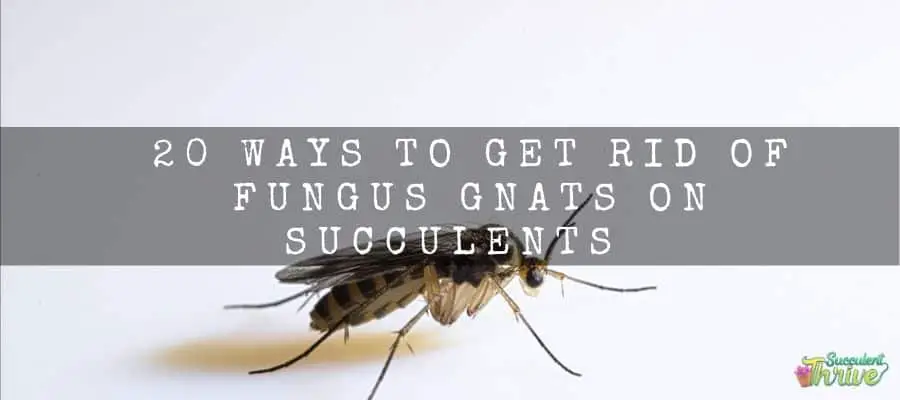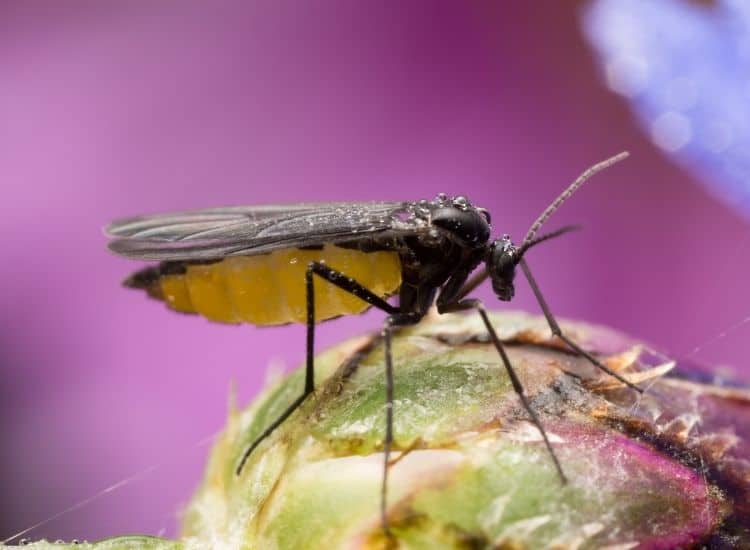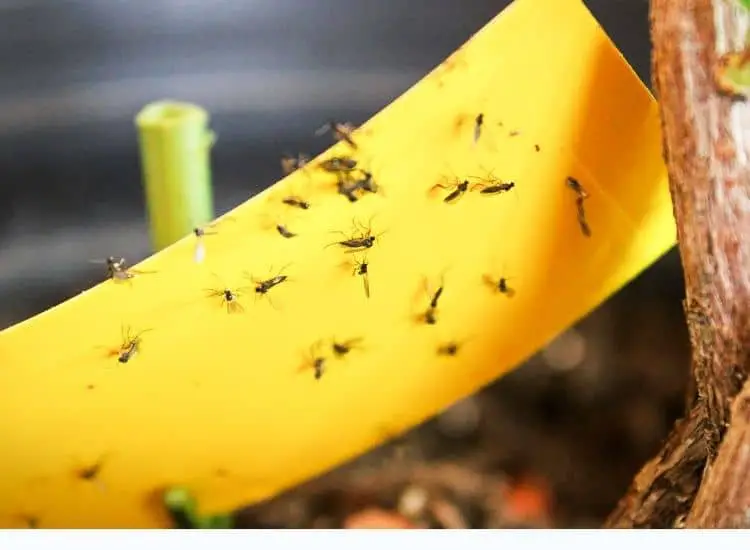Are Fungus gnats bad for succulents? Fungus gnat is a serious problem and it can harm and even kill your plant. That is the reason you need to dispose of Fungus gnats when you notice them! Usually, adult gnats are not harmful, yet your plants’ roots will be damaged because the larvae will start eating the succulents’ seeds. Once the succulent meats are damaged, you can see that the leaves are turning to yellow color, dropping leaves, and plant growth will also be decreased.

The grown-up gnats themselves are, for the most part, innocuous; however, the hatchlings that bring forth from each one of those eggs will benefit from the foundations of your plant and begin to hurt it.
As your plant’s roots become harmed, you may start seeing dropped, yellowing leaves, a stoppage in plant development, and different indications of root harm. The presence of an abnormally vast number of fungus gnats proceeds, it will kill your succulent. The most known reason for the fungus gnat problem is over-watered indoor plants.
As the adult insects lay their eggs and the invasion keeps developing. Have confidence, you can dispose of fungus gnats without destroying your plants. In the worst case scenario, let the contaminated plants dry out totally, which murders the fungus gnat larvae in it. Grown-up gnats live around few weeks and lay up to 300 eggs in rich, damp soils. Inside 4-6 days, small hatchlings arise and start benefiting from plant roots during their lifetime. The pupal stage endures 3-4 days before adults leave the dirt and create the future.
On account of their relatively short development, plants can have each stage egg, hatchlings, pupae, grown-up in different ages.
Why are my succulents attracting gnats?
Maybe you have not noticed, there is enough moisture in your succulent pot for the gnats to put their eggs. Gnats love wet soil. Let the soil dry, and be careful when you water these plants. Regularly monitor the top of the soil for moisture content.
Though gnats typically stay close to the highest points of pots, they may discover their way to the waste openings on the underside of a pool and begin laying eggs there, as well. On the off chance that this occurs, cover the outflow openings with a piece of cloth to keep the gnats from getting in or out of the opening; however, they likewise allow water to go through without a problem. Long as there’s decaying plant matter, you will find fungus gnats hanging around.
What are Fungus gnats?
Fungus gnats are small insects that look like a mosquito and grow in the soil. These fungus gnats are attracted if the succulent soil is moisture, where they can put a lot of eggs. There is no harm to the humans from these fungus gnats directly. Not biting at all. But it can damage your succulents. They have transparent grey color wings, long legs, and a thinner body.
Fungus gnats larvae
Not only adult fungus gnats, the larval stage of this animal also harm the succulents. Fungus gnat larvae are legless with whitish body color and blackhead. These tiny fungus gnat larvae are the one harm your plant. once adult females lay eggs in moist soil, fungus gnat larvae came out from the eggs,
they attached to the plant root and suck nutrients out from the plants. It is important to get rid of adults as well as larvae of the fungus gnat.

Gnats infestation Symptoms and signs
- Yellowing leaves- leaves of your succulent will change into yellow color after few days.
- Slow growth – You will observe the slow growth rate of the plant. To observe this symptom you have to observe carefully and regularly. Note the length of the stem and leaves of your plant. This will help you to understand the slow growth rate of the succulent.
- Parts of the plant may be damaged – If you check the plant carefully, you may see some part of the plant is damaged.
you can use a simple trick to detect the presence of gnats by using a potato slice/wedge. you can place a potato slice/wedge in the succulent pot for few days. If there are any fungus gnats, you can detect those in the potato. You have to turn the potato and look for their presence. Then after this effective identification, you can go for the treatments.
Read more How To Get Rid Of Aphids On Succulents | Full Guide
How do you get rid of Fungus gnats on succulents?

Set an apple cider vinegar trap
Use apple cider vinegar to avoid fungus gnat on the succulents. Get a narrow compartment and fill it with water and apple cider vinegar. Add few drops of dish soap and afterward mix the blend. Spot the holder either on top of your influenced plant’s dirt or close to its pot. Vinegar will attract the fungus gnat, and dish soap helps you trap them inside. You can also use diatomaceous earth on top of the succulent soil. It can dehydrate the gnats and kill them.
Hydrogen peroxide
An antibacterial specialist and against fungus gnats. We love hydrogen peroxide (H2O2) because it separates into plain water (H2O) and oxygen (O2) – so it’s absolutely earth safe. You can add hydrogen peroxide to the parts of the roots. Don’t sweat it. You can empty the arrangement into the dirt to get all the eggs, just as placed some in a splash jug and cover the leaves.
Like most medicines, reuse it consistently until the fungus gnats disappear.
Cinnamon powder
Cinnamon powder is an antifungal powder that can be very practical against fungus gnats. It helps control fungus gnats and eliminating them. Cinnamon powder is a characteristic fungicide demonstrated to be exceptionally viable against damping off. Just sprinkle enough cinnamon on the plant, and if necessary, you can use it again and again.
Wine and Dish soap trap
Another method to get rid of fungus gnats is the use of wine and dish soap. Take red wine, add dish cleanser, and put it in a bowl. Keep this mixture near the succulents to kill the Fungus gnats. The gnats love it and will fall into it and die soon.
Essential Oils
Adult gnats and different types of flies can’t bear the smell of citronella. One approach to discourage gnats and shield them from amassing around your plants outside is to utilize a basic citronella oil splash that you can make at home. You can use any citronella oil for this remedy. add 20-25 drops of citronella oil into 50 ml of water and put them into a spray bottle. Spray twice per day.
Neem oil
Neem oil is additionally a viable soil douse to battle fungus gnat larvae. Make oil thinned with water and straightforwardly douse the dirt at the plant’s underlying foundations. Likewise, you can shower the upper bit of the plant to keep grown-up gnats under control. This can kill the larvae as well.
UV Light Bug Zapper
UV light bug zapper attracts bugs by emitting blue light. This blue light lures the insects into the center of the instrument and kills them. This trap will not resolve your problem completely. But it will keep the gnats population under control.
Potato slices
Potato slices can Controls fungus gnat larvae and fungus gnat adults.
Disposable Gnat traps
Because of the smell of this trap, the fungus gnats will go into this trap and die when drawn into the water
Diluted Rubbing alcohol spray
Blend 1 cup rubbing alcohol with 1 quart of water, fill a spray bottle. Spray it on the parts of the plant. Test a leaf first to check the blend isn’t excessively harsh.
Lemon Oil
You can use around twenty drops of Lemon oil with few drops of rosemary essential oil and lavender essential oil, then mix it with rubbing alcohol.
Tobacco Layer
You will have to use a cigarette to do this. Take a thin layer from the powder inside the cigarette. It can prevent fungus gnats.
Insecticidal Soap
Insecticidal Soap takes away the defensive waxes that cover the bug, and it can dehydrate and kill the fungus gnats.
How do I get rid of Fungus gnats naturally?
Tea tree essential oil
Eliminates defensive waxes covering the bug, bringing about drying out. This contains average insecticidal properties that will rapidly execute off grown-up fungus gnats.
Peppermint essential oil –
You can use a peppermint oil mixture to kill fungus gnats. You can mix water and peppermint oil and put it in a spray bottle. Now you can use this spray as an excellent option to take away the fungus gnats from your beautiful succulents.
Rosemary essential oil –
This combination can help you make your succulents happy and healthy. Use few drops of Rosemary oil with clove, peppermint oil, and orange oil. Now mix it and fill in a small spray bottle. Then spray it on your succulents to kill the fungus gnats. Geranium essential oil – Make a mixture with few drops of geranium essential oil and few drops of citronella essential oil and blend with lemon essential oil to make it a better combination to kill the fungus gnats.
Cedarwood essential oil –
Apply this at the beginning of the day or night for best outcomes. Use again regularly if needed.
Neem essential oil. –
Neem oil is referred to for its utilization as a safe and powerful insect spray. Use it for the fungus gnats, and you can get good results.
Eucalyptus essential oil –
This oil can make the fungus weaker and help you get your beautiful succulents back.
Most importantly make a schedule to water your plants. excess watering will harm your plant.
How do I get rid of Fungus gnats by Chemicals?
Hydrogen peroxide purifies the dirt and kills the larvae.
What causes fungus gnats on succulents?
It can be too much water or not using the soil correctly.
What are the damages done by gnats?
- It can harm roots and trick plant development
- Huge root harm and
- Root rot growths
Related Questions
How do you get rid of Fungus gnats permanently?
Inspect plants thoroughly when you buy for indications of bugs. Turn up soil cautiously close to the plant’s base and search for the gleaming, transparent larvae. Fungus gnats do best in wet soil. Be mindful not to overwater, particularly during cold weather months when the plants utilize less.
Use Yellow Sticky Traps put on a level plane at the dirt surface to catch vast quantities of the egg-laying adult fungus gnat. The gnats are pulled into yellow sticky traps and effectively get rid of the snare before laying more eggs.
Will vinegar kill Fungus gnats?
The best way to use vinegar to mix with beer and a few dish soap drops. Use a closed jar with a lid with few openings (You can make holes on the top). Fill with the mixture and keep this trap near the succulents to get rid of the gnats.
Do coffee grounds repel gnats?
Coffee grounds are toxic for the gnats.
You can kill fungus gnats by using coffee grounds. There is a powerful smell that gnats can not bear. This smell will trouble the bugs and fend them off.
What is the best way to get rid of Fungus gnats?
Use Vinegar trap and Neem Oil with dish soap and beer, or you can use few drops of dish soap with water and see if it works.
Where do fungus gnats come from?
It can be found during the spring and winter in California.
What scents deter gnats?
- Eucalyptus essential oil.
- Peppermint essential oil.
- Cedarwood essential oil.
- Rosemary essential oil.
- Geranium essential oil.
- Vanilla
Does Vanilla extract keep gnats away?
Gnats hate the smell of Vanilla. Add a spoon of pure Vanilla with water (the same amount as Vanilla) to hinder mosquitoes and gnats. Once mixed, apply the mixture to the parts of the succulent. These non-harmful anti-agents will work. So reapply if necessary.
Fungus gnats vs. fruit flies
Their long legs and long reception apparatuses give them a mosquito-like appearance; however, they are a whole lot more modest in size. Gnats have a slenderer body with long legs. Their flight is variable, and they are flying slower than fruit flies, and just like the mosquitos when flying.
Read more 14 Ways To Treating Spider Mites On Succulents


